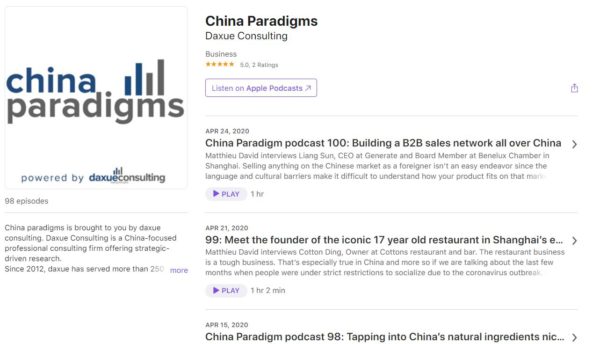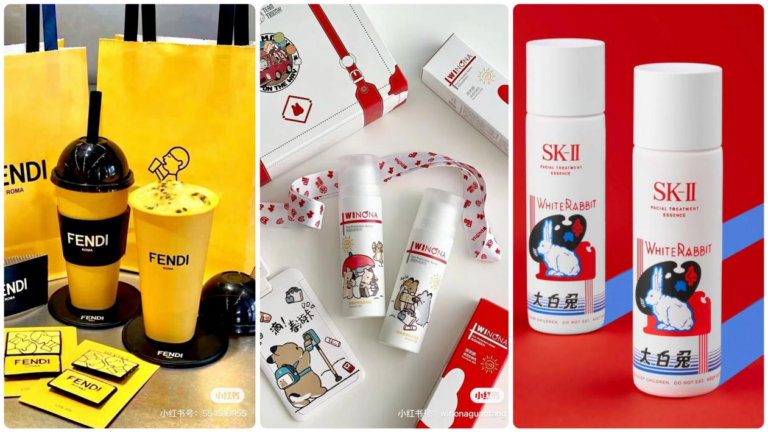Every brand has a story, and brands can narrate their story to engage with their audience. Through a narrative, an audience can become more sentimentally connected with a brand, which could in turn foster greater brand equity and loyalty. A strong brand storytelling in China goes beyond merely advertisement; brands that tell a story convey messages that grab consumers’ attention, making them stick with the brand because it is relevant and interesting.
This article is based on some of the content from our full analysis of branding tactics in China.
What are the basic building blocks of compelling brand storytelling in China?
Here is your ultimate guide which explores the following concepts:
First step in brand storytelling in China: Define your brand voice and tone
Every brand has a personality, which can be shaped by embracing a consistent a brand voice and tone. It is crucial to understand the distinction between the two and what it means for how consumers perceive your brand.
Brand voice embodies and expresses your brand personality and core values through in the words chosen to communicate with your audience. Brand tone refers to the way you convey your brand’s message, or the definitive style of writing and speaking to your audience, and it has to stay consistent in order to effectively communicate brand storytelling in China.
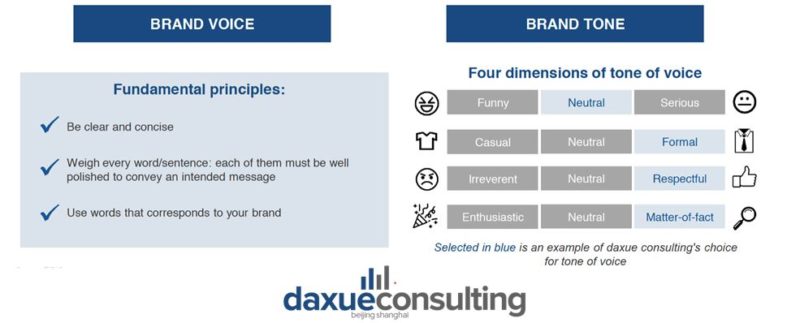
Sources: TIDIO, daxue consulting branding report, analysis of brand voice and brand tone
Budweiser case study: A tasteful and effective brand voice in the Chinese market
Budweiser’s word choice in its China market campaigns reflects its brand identity as being casual and friendly. Its slogans, normally involving enthusiastic and fun undertones, also align with their core values of authenticity, ambition, and freedom. Its marketing on Tmall, conveys the message that their beer makes every gathering better. This reflects the company’s dream: bringing people together for a better world.
A tactful brand storytelling in China can be bolstered with a celebrity endorsement. Budweiser chose a celebrity endorser who matches its brand values to enhance its brand voice. The famous Cantopop singer Eason Chan has been Budweiser’s brand endorser since 2016. From then on, Chinese consumers have felt closer to the brand, a proven success of the localization of foreign brands in China. The celebrity’s personality and the brand’s value share commonalities: being spontaneous and friendly.
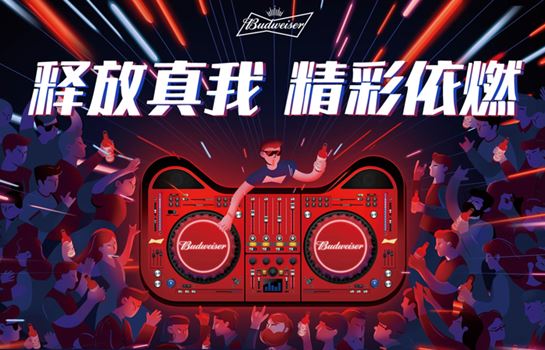
Source: Tmall, Budweiser’s Tmall home page, “release the real me, still igniting my life” the slogan of Budweiser China
Brand Promise: What your brand must be and do for your customers
A brand promise is a value or experience that customers can expect to receive every time they interact with your brand. It reflects a brand’s consistency on what a brand must be and do for its customers; the more a brand delivers on that promise, the stronger the brand value.
White Rabbit Creamy Candy: Brand storytelling in China through nostalgia
The 70-year-old iconic candy brand is not merely a creamy candy; for most Chinese millennials it is creamy happiness wrapped in nostalgia. While many snack and candy brands are constantly finding new recipes flavors, White Rabbit Candy has maintained the traditional recipe, which has now become a symbol of childhood bliss in China.
According to its official website, “White Rabbit selected the best raw material. Each pot of syrup is hand-made for 40 minutes by the workers.” It extends its brand promise of nostalgic touch through being made into ice cream, sweetened milk, and even innovatively co-branding with brands in other segments (read more on its co-branding and nostalgia marketing). Its brand promise of a nostalgic touch to their candy is a prime example of brand storytelling in China.
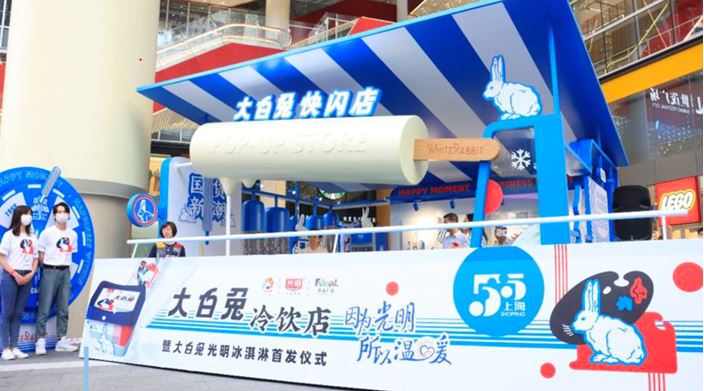
Source: Sohu, White Rabbit Creamy Candy’s pop-up store in Shanghai (June 2020)
Inspiration and Aspiration: Inspired by vs. Aspire to be
The distinction between inspiration and aspiration can be broken down into three categories—incentive, time frame, and source:
- Inspiration often comes from an instant trigger, while ambition is a hope or an ambition becoming or acheiving something great.
- Inspiration can be thought of something short term, where one is temporarily stimulated in feeling motivated; in contrast, aspiration is a longer process by which an individual is motivated for the long term.
- Being inspired derives from an extrinsic source, while aspiration originates intrinsically.
How are these two incorporated together in branding?
Inspiration comes from an external trigger, brands can play the role of this trigger, whether it be from the products, the marketing message, or the brand story. However, as aspiration has a longer-life, it is brands that align with consumer aspirtions that guarantee themselves more loyalty. The challenge is that aspiration comes from within, so brands must first understand the consumers to understand what their aspirations are. Secondly, aspirations are for the well-being of the consumers, therefore brands must also support the wellbeing of consumers in order to capitalize on aspirations.
Many fitness start-ups in China draw a parallel to this two-step process of getting its consumers to be inspired then aligning with their aspirations. The fitness app KEEP is an example. The app allows users to inspire others through sharing their own progress, while at the same time, encourages consumers to keep on the long path of personal well-being and fitness.
For luxury brands in China, inspirational content can also enhance a strong emotional connection to Chinese audiences with a focus on the heritage and founding story of the brand. Luxury brands also cater their brand message to align with consumers who aspire to be elegant and wealthy.
Coca-Cola illustrates brand storytelling in China through social and cultural aspirations
Living in a collectivist society, Chinese consumers can be more responsive to shared cultural aspirations than their own individual ones Coca-Cola China’s advertisement for Chinese New Year 2017 incorporates Chinese cultural elements in order to evoke a sense of cultural aspiration amongst consumers. The overarching theme of the advertisement is “Sticking Together,” which is an extension of its overall “Taste the Feeling” campaign at the time.

Source: Youtube, Coca-Cola’s Chinese New Year 2017 commercial
In North America, Coca-Cola masters brand storytelling through Santa Claus for its holiday season commercials to the extent that consumers can attribute Santa’s appearance to the brand. To effectively reach Chinse consumers, the soda brand had to take another approach that better fits the aspirations of Chinese people.
Coca-Cola highlights the importance of family gatherings during Chinese New Year. The commercial depicts a Chinese family gathering on a snowy winter night, and the boy leaves the dinner to find a “family” of snowmen in the backyard who are offering Coca-Cola. The main subtitle reads: “No one can stop me when I taste the feeling, nothing could ever bring me down.” Although Coca-Cola aims to evoke some sense of aspiration, the commercial does inspire people in the beginning as the initial thought to be with their family, and the aspiration comes after to achieve the act of something greater. Coca-Cola appeals directly to the Chinese audience’s traditional cultural values and aspirations, and the brand is a prime example of the localization of foreign brands in China.
Strengthen your customer’s offline experience with interior design
A good first impression offline starts with interior design, especially with the prominence of new retail in China, a term coined by Jack Ma that describes a retail experience integrating digital and offline. Chinese consumers are no longer going out merely for shopping: they are seeking an experience. Design of a store becomes crucial to gain visibility and maintain a strong brand image.
“In the O2O era, interior design becomes even more important than it used to be… Interior design is an ambassador that allows a brand to be more persuasive and helps to form the attitudes it wishes to express,”
Sofya Bakhta, marketing strategy analyst at daxue consulting
Athleisure brand Particle Fever’s engaging retail experience
Interior design is an opportunity to create a memorable impression unachievable elsewhere, and Particle Fever is a noteworthy example. The Shanghai-based designer sportswear brand aims to stand out with avant-garde designs and innovative fabric. Its retail stores embody the concept of a “sports lab,” allowing consumers to fully experience the brand’s intersection of fashion, tech, and fitness. With the rising prominence of incorporating athleisure as a part of the Chinese consumer lifestyle, the brand ensures that it offers a unique experience to its customers by engaging them in-store, thus strengthening its brand storytelling in China.
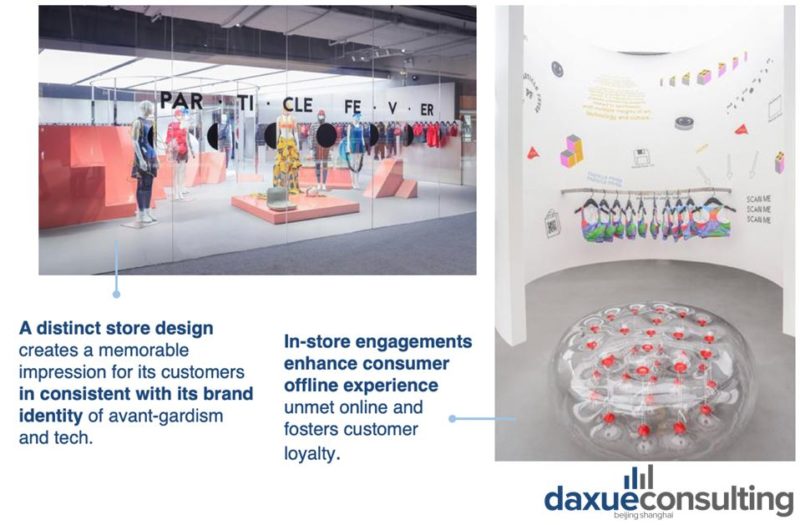
Image source: Sohu, daxue consulting analysis of Particle Fever’s immersive store experience
Building trust with personal brands
Customers trust a human being more than a logo. This is when personal brands come in: either a founder becomes a public figure due to his or her company’s success, or a public figure leads to the establishment of a brand to enhance brand storytelling in China.
The former type of personal brand is often seen in the tech industry. For instance, Steve Jobs of Apple, Jack Ma of Alibaba, or the founder and CEO of Xiaomi who’s received less public attention—Lei Jun. Xiaomi’s success as an electronics brand earns the founder his recognition, which in turn strengthens the brand’s image. The low-profile founder Lei Jun is seen as being more connected to the people and frequently engages with netizens on his social media, revealing its friendly personality. His image as a businessman serves as a personal branding for Xiaomi, building on trust from consumers.
The latter form of a personal brand often seems more intuitive; for instance, Li Ning. A Chinese gymnast champion rose to fame in the 90’s and founded an athletic brand with his own name. The brand Li Ning incorporates his values and attributes, and consumers ultimately associate the brand with the founder, therefore enhancing brand equity. The goal of the brand is to provide Chinese athletes a national brand to wear on the world stage of the Olympics, and even today, it serves as a brand that fosters the Chinese people’s national pride.
What this means for brands in China
- Engage Chinese consumers with brand storytelling. For localization of foreign brands in China, set a brand voice and tone as well as inspirational and aspirational elements to grab the consumers’ immediate attention.
- Foster trust in consumers with brand promise and personal brands. Having consumers being personally connected to your brand drives brand equity.
- Extend your brand storytelling with an experience. Interior design strengthens what consumers’ existing connection with your brand and is a crucial investment especially in the new retail era.
Author: Michelle Law
See our full report on branding in China
Listen to over 100 China entrepreneur stories on China Paradigms, the China business podcast
Listen to China Paradigm on Apple Podcast
